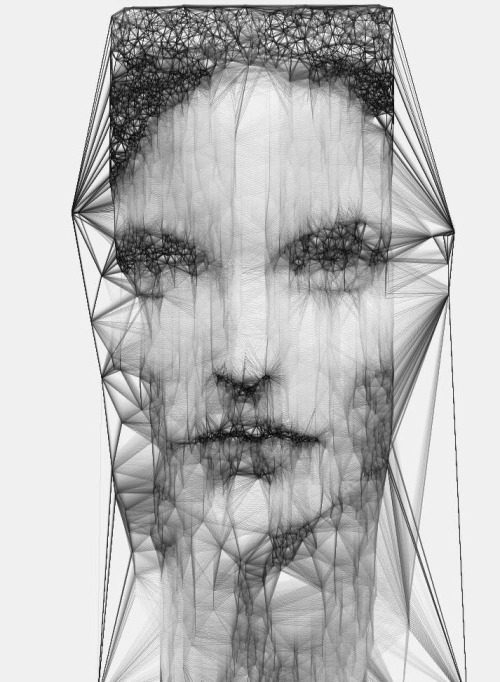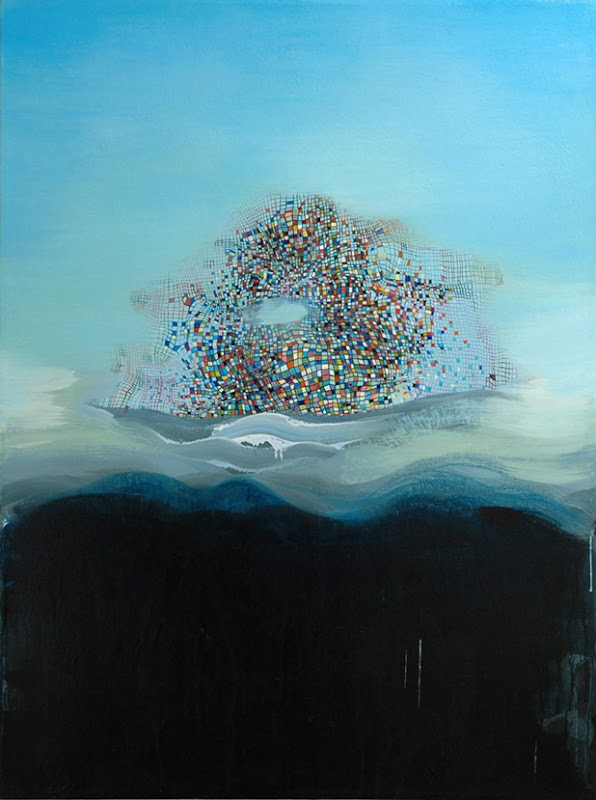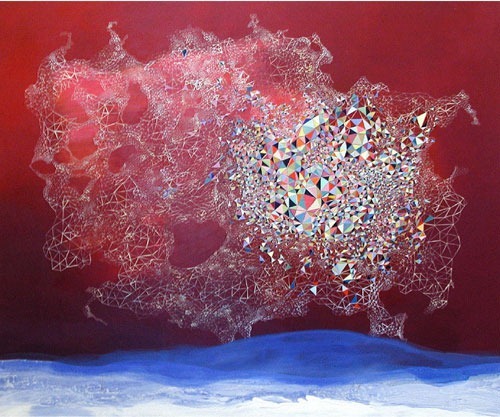Thursday, February 16, 2012
Thomas Koenig
Thomas Koenig:
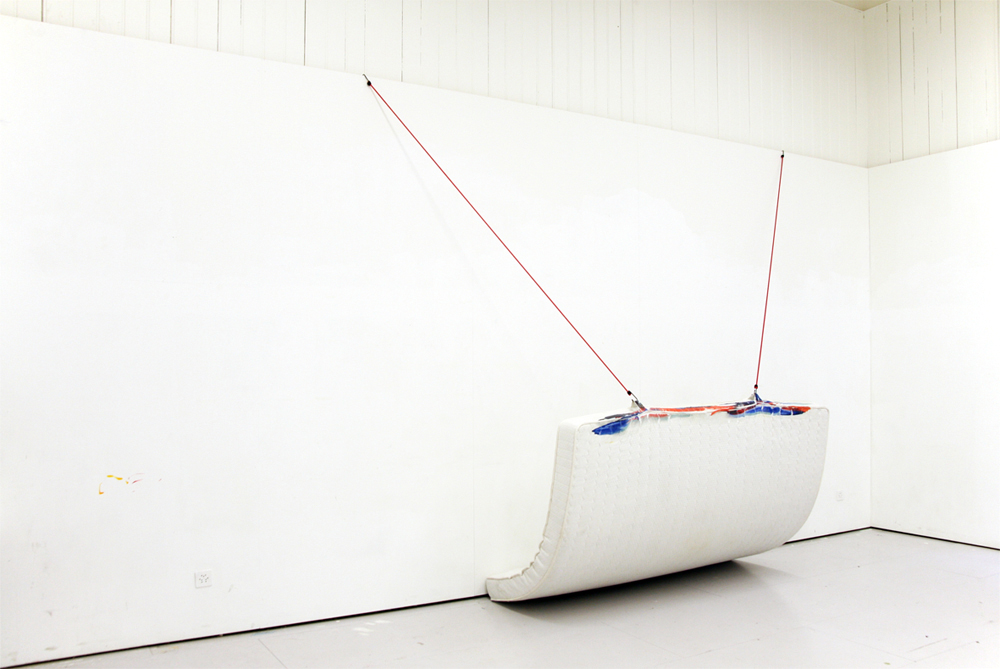
(Untitled) detail, 2012
-
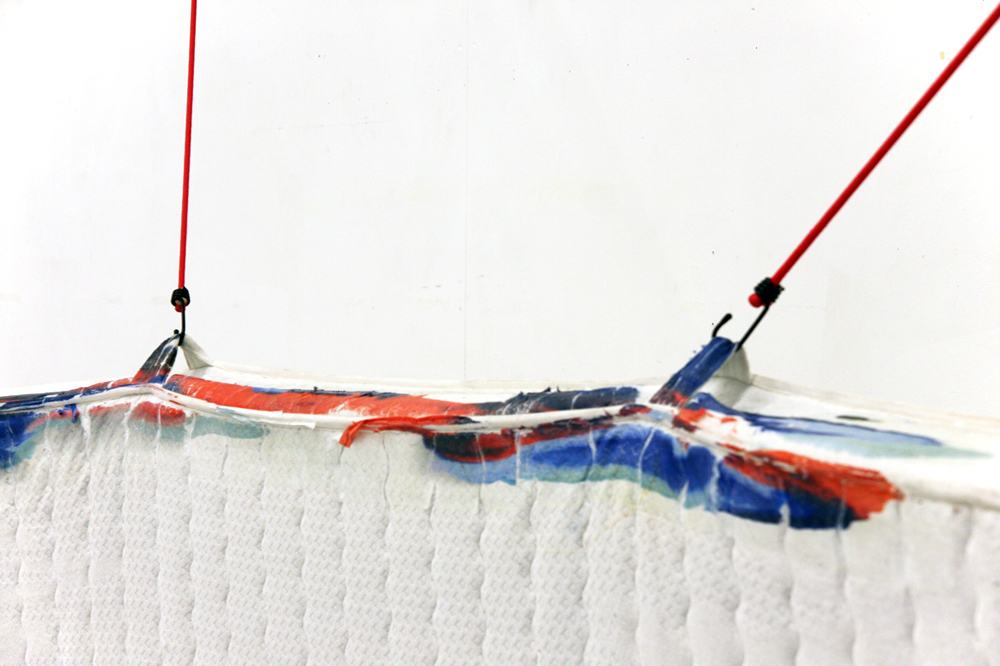
(Untitled) detail, 2012 courtesy of THOMAS KOENIG
Swiss artist THOMAS KOENIG weaves sculptural installations developped from an intuitive process of playing with anything that catches his eye and triggers a sculptural response; having the right shape, color or volume. As a result, his working materials and subject matter are to be found everywhere; his aim is to divert materials from their prescribed functions, inventing ways of making these things improper again and thus, inhabiting a new reality.
THOMAS mainly works with sculpture although he also realizes performances, drawings and paintings, which are often incorporated in his installations.
And good news: THOMAS KOENIG is currently having a new solo exhibition entitled NEVER TRUST A MAN WITH NO CELLPHONE at Aad Galerie, Geneva until February 25, 2012. Stay tuned!

(Untitled) detail, 2012
-

(Untitled) detail, 2012 courtesy of THOMAS KOENIG
Swiss artist THOMAS KOENIG weaves sculptural installations developped from an intuitive process of playing with anything that catches his eye and triggers a sculptural response; having the right shape, color or volume. As a result, his working materials and subject matter are to be found everywhere; his aim is to divert materials from their prescribed functions, inventing ways of making these things improper again and thus, inhabiting a new reality.
THOMAS mainly works with sculpture although he also realizes performances, drawings and paintings, which are often incorporated in his installations.
And good news: THOMAS KOENIG is currently having a new solo exhibition entitled NEVER TRUST A MAN WITH NO CELLPHONE at Aad Galerie, Geneva until February 25, 2012. Stay tuned!
Tuesday, February 14, 2012
Ai Hasegawa
Ai Hasegawa:



Ai Hasegawa
Work from Extreme Environment Love Hotel
Article / Interview reposted from We Make Money Not Art - Image credits: Anthony Dunne
“… Extreme Environment Love Hotel simulates impossible places to go such as the Earth of three hundred million years ago (during the Carboniferous period), or the surface of Jupiter by manipulating invisible but ever-present environmental factors, for example atmospheric conditions and gravity
Our bodies would struggle to survive if we were propelled back to the Carboniferous period. It is estimated that during that time, the peak oxygen content of the atmosphere was as high as 35%, compared to 21% today. This oxygen level resulted in insect and amphibian gigantism–creatures whose size is constrained by respiratory systems that are limited in their ability to diffuse oxygen. For example, the ancestor of the dragonfly, the Meganeura, grew up to seventy-five centimeters due to the huge concentration of oxygen in the air. However, such high levels of oxygen would be toxic to the fragile bodies of human beings.
Life on Jupiter doesn’t sound very pleasant for us either. The atmospheric environment of the largest planet within the Solar System is one of strong gravity, high pressure, strong winds, and extremely cold temperatures.
How might our bodies change, struggle or even adapt with varying conditions around us?
The first of Ai Hasegawa’s Extreme Environment Love Hotel room, the carboniferous one, is currently on view at the work in progress show of the Royal College of Art. The prototypes show how couples would have to carry a suitcase containing higher levels of oxygen that recreate the atmosphere of the Carboniferous period, they would also be surrounded by plants similar to the ones that proliferated in the warm and humid climate: large trees covered with bark and huge ferns growing in swamps.
If you want, you might probably be able to make a baby under the hyper gravity…” – We Make Money Not Art



Ai Hasegawa
Work from Extreme Environment Love Hotel
Article / Interview reposted from We Make Money Not Art - Image credits: Anthony Dunne
“… Extreme Environment Love Hotel simulates impossible places to go such as the Earth of three hundred million years ago (during the Carboniferous period), or the surface of Jupiter by manipulating invisible but ever-present environmental factors, for example atmospheric conditions and gravity
Our bodies would struggle to survive if we were propelled back to the Carboniferous period. It is estimated that during that time, the peak oxygen content of the atmosphere was as high as 35%, compared to 21% today. This oxygen level resulted in insect and amphibian gigantism–creatures whose size is constrained by respiratory systems that are limited in their ability to diffuse oxygen. For example, the ancestor of the dragonfly, the Meganeura, grew up to seventy-five centimeters due to the huge concentration of oxygen in the air. However, such high levels of oxygen would be toxic to the fragile bodies of human beings.
Life on Jupiter doesn’t sound very pleasant for us either. The atmospheric environment of the largest planet within the Solar System is one of strong gravity, high pressure, strong winds, and extremely cold temperatures.
How might our bodies change, struggle or even adapt with varying conditions around us?
The first of Ai Hasegawa’s Extreme Environment Love Hotel room, the carboniferous one, is currently on view at the work in progress show of the Royal College of Art. The prototypes show how couples would have to carry a suitcase containing higher levels of oxygen that recreate the atmosphere of the Carboniferous period, they would also be surrounded by plants similar to the ones that proliferated in the warm and humid climate: large trees covered with bark and huge ferns growing in swamps.
If you want, you might probably be able to make a baby under the hyper gravity…” – We Make Money Not Art
todays-smile.net by qubibi
todays-smile.net by qubibi:

todays-smile.net is a website created by qubibi after the 3.11 Earthquake in Japan, and the nuclear power plant incidents that followed. The website shows an audiovisual piece on full-screen based on generative patterns and electronic sounds. The following pictures are some screenshots from the piece, just visit it here. See more;








The animation above is a GIF edited by dvdp from a little part of todays-smile.net





Fashion Week's Exquisite Corpses
Fashion Week's Exquisite Corpses:
FAM NYC, a new creative collective, launched the Exquisite Corpse Project last week with an opening exhibition at the old Essex Street Market in the Lower East Side.
A nod to the Surrealist parlor game of the 1920s, Exquisite Corpse presents a blind collaboration between thirty-three New York artists, including Dustin Yellin, John Gordon Gauld, Sarah Kurz, and Alex Eagleton, who was also part of the project selection committee (along with Grey Area’s Kyle DeWoody and Alix Frey of Jonathan LeVine Gallery). Assigned to envision the top, middle, or bottom of a corpse, each artist created their own interpretation on 3×4 wood panels. Results ranged from literal—like the clean, cold portrait of feet that dangled ominously above the floor—to abstract, like the bright, green, geometric middle.
As its opening date coincided conveniently with the start of fashion week in New York, the art-focused endeavor has several fashion ties: model Arizona Muse hosted last night’s launch party, former Black Book Fashion Editor Marina T. Schindler is the project’s Creative Director, and its space will welcome several private fashion week presentations and parties throughout the weeklong residency.
The exhibition will remain on view through Thursday the 16th, after which the art will be auctioned to benefit Art Start, a nonprofit providing art therapy to at-risk youth.

The Exquisite Corpse Project (installation view)

The Exquisite Corpse Project (installation view)

The Exquisite Corpse Project (installation view)

The Exquisite Corpse Project (installation view)

FAM NYC, a new creative collective, launched the Exquisite Corpse Project last week with an opening exhibition at the old Essex Street Market in the Lower East Side.
A nod to the Surrealist parlor game of the 1920s, Exquisite Corpse presents a blind collaboration between thirty-three New York artists, including Dustin Yellin, John Gordon Gauld, Sarah Kurz, and Alex Eagleton, who was also part of the project selection committee (along with Grey Area’s Kyle DeWoody and Alix Frey of Jonathan LeVine Gallery). Assigned to envision the top, middle, or bottom of a corpse, each artist created their own interpretation on 3×4 wood panels. Results ranged from literal—like the clean, cold portrait of feet that dangled ominously above the floor—to abstract, like the bright, green, geometric middle.
As its opening date coincided conveniently with the start of fashion week in New York, the art-focused endeavor has several fashion ties: model Arizona Muse hosted last night’s launch party, former Black Book Fashion Editor Marina T. Schindler is the project’s Creative Director, and its space will welcome several private fashion week presentations and parties throughout the weeklong residency.
The exhibition will remain on view through Thursday the 16th, after which the art will be auctioned to benefit Art Start, a nonprofit providing art therapy to at-risk youth.

The Exquisite Corpse Project (installation view)

The Exquisite Corpse Project (installation view)

The Exquisite Corpse Project (installation view)

The Exquisite Corpse Project (installation view)
Artist Profile: Tommy Hartung
Artist Profile: Tommy Hartung:

I don’t think of my work as surrealist. Surrealism presupposes an ordered, sensible world where something foreign or fantastic has intruded. The reality created in my video is so far removed from the reliability of a real world concept like gravity or time that it is hard for me to think about it relating to surrealism. There is definitely a relationship between early cinema and my current work, but I would not characterize it as nostalgic exactly. I am interested in the methods, pace, and intensity of early cinema. I’m not trying to use these archaeologically. Films like Dreyer’s Passion of Joan of Arc, or Eisenstein’s Ivan the Terrible have a pulverizing intensity. Nikolay Cherkasov in Ivan, and Maria Falconetti in Joan of Arc are almost in trance states as the film unfolds around them. There is a tension in early cinema that I find hard to match, and try to build in my work.
Much of your work includes a still, lone figure amidst a changing environment. When there are multiple figures, like the busts in Anna, there's a sinister or disharmonious feeling. Is there something to this in how your characters operate or relate? Do you think of cinematic roles with these figures? How do you incorporate your references (to literature, documentary, and more)?
The interaction of characters can sometimes be sinister, cold, or terse. The characters I develop tend to be workman-like in their tasks or roles. I also think there is a very dry gallows humor, romance or intimacy, and sense of everyday doldrums in these characters. The way they relate to each other is the way I feel most people interact. I definitely consider each character playing a role—the damsel-in-distress, an Edgar Rice Burroughs explorer, plucky sidekick, or reluctant hero. Incorporating references is not something I try to tack on to the work. Sometimes I have a specific film in mind that I try to channel, or a piece of a recognizable image. As I work on a piece, particularly video which takes the better part of a year to shoot and edit, I watch and re-watch the same films, or re-read the same book. Elements seep into the work via osmosis.
For Anna and The Ascent of Man, you showed the videos alongside characters, objects, and even living things from the film itself. Seeing them in the film while seeing them in life somehow broke a wall, almost confusedly: they're distant settings that you grow intimate with over the course of seeing the work, but then, they're in the room to be related to (or not). Would you talk about your decision to do so?
Showing objects from the video in a space is a very different experience from watching the video itself. In many ways it’s like taxidermy. Tracking, shooting, capturing, and finally when you’ve gotten this elusive creature, you want the trophy, a remembrance, fixed in time. The live character is deflated and transformed into a monument, embalmed in the mausoleum of the gallery. I’m sentimentalizing here, but it feels more than a little bit like this. I’m not totally sure yet if showing objects from a video alongside the video itself is for my own satisfaction, or for the viewer’s.
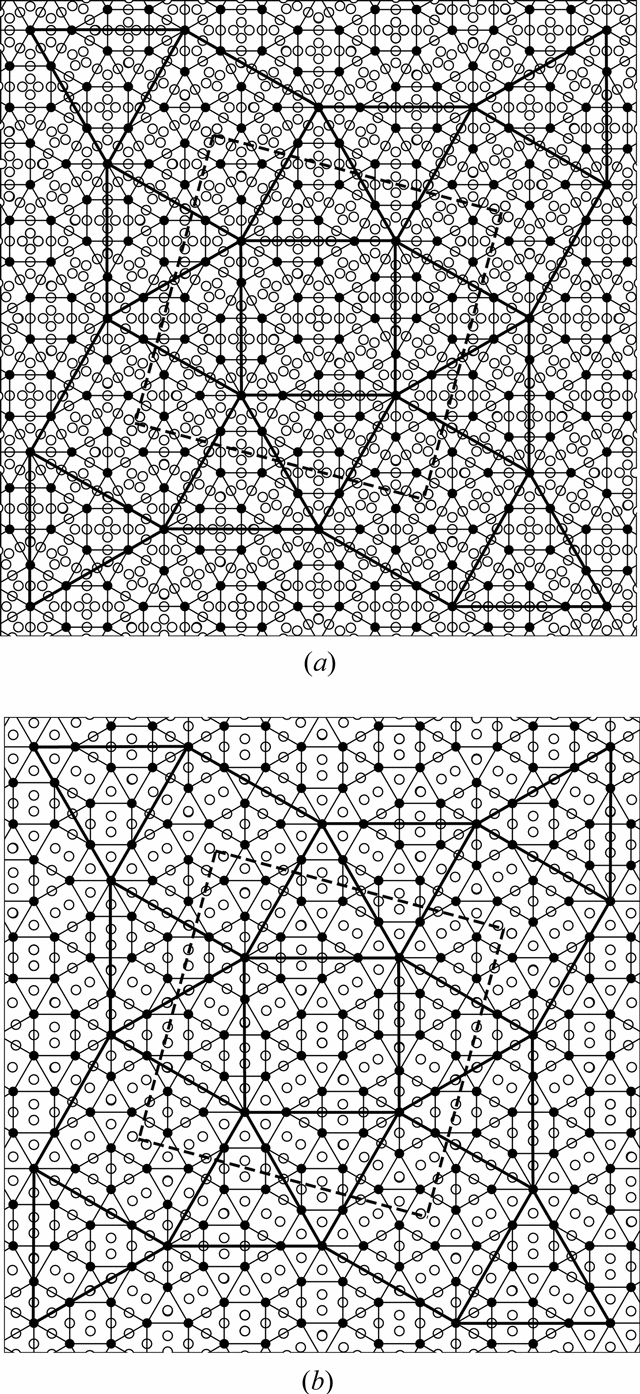
Age:
Location:
Ridgewood, Queens
How long have you been working creatively with technology? How did you start?
I have been working with technology since high school. My first videos were made as educational videos for my school. In my free time i started experimenting and remixing the videos with the analog beta decks and my first found footage montage was made when i started learning digital editing.
Describe your experience with the tools you use. How did you start using them?
Using a camera is a lot like using a canvas for a painting. Each frame is a sacrosanct image. I excessively investigate each angle and vista in a scene, like Cézanne and his mountain. I came to use the tools I do by process of elimination.
Where did you go to school? What did you study?
I graduated from SUNY Purchase with a BFA in Sculpture, and took my MFA at Columbia.
What traditional media do you use, if any? Do you think your work with traditional media relates to your work with technology?
Much of my process is rooted in traditional media. Setting up shots for animation draws on theatre, painting, and early cinema methods. The materials used in the tableau I shoot are varied, but have included anything from salt, plaster, matchsticks, and Baroque busts to cheapo Animatronics. The activity of collecting, jury-rigging, assembling materials also fits into a tradition of making and aesthetics that is quite old fashioned. The relationship between traditional and technological is in one sense happenstance, in other ways, it is deeply considered.
Are you involved in other creative or social activities (i.e. music,writing, activism, community organizing)?
I teach at SUNY Purchase where I went to school. Teaching there allows me to share my experiences as an alum and hopefully add something to the community of young artists.
What do you do for a living or what occupations have you held previously? Do you think this work relates to your art practice in asignificant way?
I’m a professor teaching video and editing. Before I became totally invested in art production, I was a chef. There is some simpatico in the process of cooking and the process of art making.
Who are your key artistic influences?
Georges Méliès, Industrial films, James Cameron, Youtube, early Edison films, Alexander Sokurov, Jan Švankmajer, cartoons.
Have you collaborated with anyone in the art community on a project? With whom, and on what?
I have collaborated with Uri Aran, Ronnie Bass, and Sam Clagnaz. I have worked with each individually on video projects, and also engage in critical dialogue with them regularly.
Do you actively study art history?
Not especially. I am aware of the artists with whom I am contemporary and try to see where I might fit in with them, and in a historical continuum of artists. But I don’t study art history regularly.
Do you read art criticism, philosophy, or critical theory? If so,which authors inspire you?
I have read the standards of critical theory, philosophy, etc., Levi-Strauss, Deleuze, Zizek, Adorno. I don’t find particular inspiration in this type of writing. Most of my reading is guided by the interests with my work. Right now I am reading a lot of pop psychology. There is something fascinating about the experiments clinical psychologists perform. Recently I read Strangers to Ourselves by Timothy Wilson.... I would really like to get him on camera.......but I might just have to fake it.
Are there any issues around the production of, or thedisplay/exhibition of new media art that you are concerned about?
I am mainly concerned with calling it "NEW" because since it is constantly evolving perhaps we should just call it technology. A sense of newness seems like a dated concept in general every second of every day there is something newer than what we can conceive at this moment as "new". The feeling of excitement people get when they experience a fresh technological development I think has more to do with manipulative advertisements playing off our social/sexual desires. I work with moving images evolving since telling stories around a campfire.


Tommy Hartung, Anna, 2011
Your work calls to mind surrealist cinema, and seems nostalgic in a way, for the earliest motion pictures. What, if anything, are you drawing from the past? Do you feel you are reinterpreting the past by using modern technological tools to create the work?
I don’t think of my work as surrealist. Surrealism presupposes an ordered, sensible world where something foreign or fantastic has intruded. The reality created in my video is so far removed from the reliability of a real world concept like gravity or time that it is hard for me to think about it relating to surrealism. There is definitely a relationship between early cinema and my current work, but I would not characterize it as nostalgic exactly. I am interested in the methods, pace, and intensity of early cinema. I’m not trying to use these archaeologically. Films like Dreyer’s Passion of Joan of Arc, or Eisenstein’s Ivan the Terrible have a pulverizing intensity. Nikolay Cherkasov in Ivan, and Maria Falconetti in Joan of Arc are almost in trance states as the film unfolds around them. There is a tension in early cinema that I find hard to match, and try to build in my work.
Much of your work includes a still, lone figure amidst a changing environment. When there are multiple figures, like the busts in Anna, there's a sinister or disharmonious feeling. Is there something to this in how your characters operate or relate? Do you think of cinematic roles with these figures? How do you incorporate your references (to literature, documentary, and more)?
The interaction of characters can sometimes be sinister, cold, or terse. The characters I develop tend to be workman-like in their tasks or roles. I also think there is a very dry gallows humor, romance or intimacy, and sense of everyday doldrums in these characters. The way they relate to each other is the way I feel most people interact. I definitely consider each character playing a role—the damsel-in-distress, an Edgar Rice Burroughs explorer, plucky sidekick, or reluctant hero. Incorporating references is not something I try to tack on to the work. Sometimes I have a specific film in mind that I try to channel, or a piece of a recognizable image. As I work on a piece, particularly video which takes the better part of a year to shoot and edit, I watch and re-watch the same films, or re-read the same book. Elements seep into the work via osmosis.
For Anna and The Ascent of Man, you showed the videos alongside characters, objects, and even living things from the film itself. Seeing them in the film while seeing them in life somehow broke a wall, almost confusedly: they're distant settings that you grow intimate with over the course of seeing the work, but then, they're in the room to be related to (or not). Would you talk about your decision to do so?
Showing objects from the video in a space is a very different experience from watching the video itself. In many ways it’s like taxidermy. Tracking, shooting, capturing, and finally when you’ve gotten this elusive creature, you want the trophy, a remembrance, fixed in time. The live character is deflated and transformed into a monument, embalmed in the mausoleum of the gallery. I’m sentimentalizing here, but it feels more than a little bit like this. I’m not totally sure yet if showing objects from a video alongside the video itself is for my own satisfaction, or for the viewer’s.

Age:
Location:
Ridgewood, Queens
How long have you been working creatively with technology? How did you start?
I have been working with technology since high school. My first videos were made as educational videos for my school. In my free time i started experimenting and remixing the videos with the analog beta decks and my first found footage montage was made when i started learning digital editing.
Describe your experience with the tools you use. How did you start using them?
Using a camera is a lot like using a canvas for a painting. Each frame is a sacrosanct image. I excessively investigate each angle and vista in a scene, like Cézanne and his mountain. I came to use the tools I do by process of elimination.
Where did you go to school? What did you study?
I graduated from SUNY Purchase with a BFA in Sculpture, and took my MFA at Columbia.
What traditional media do you use, if any? Do you think your work with traditional media relates to your work with technology?
Much of my process is rooted in traditional media. Setting up shots for animation draws on theatre, painting, and early cinema methods. The materials used in the tableau I shoot are varied, but have included anything from salt, plaster, matchsticks, and Baroque busts to cheapo Animatronics. The activity of collecting, jury-rigging, assembling materials also fits into a tradition of making and aesthetics that is quite old fashioned. The relationship between traditional and technological is in one sense happenstance, in other ways, it is deeply considered.
Are you involved in other creative or social activities (i.e. music,writing, activism, community organizing)?
I teach at SUNY Purchase where I went to school. Teaching there allows me to share my experiences as an alum and hopefully add something to the community of young artists.
What do you do for a living or what occupations have you held previously? Do you think this work relates to your art practice in asignificant way?
I’m a professor teaching video and editing. Before I became totally invested in art production, I was a chef. There is some simpatico in the process of cooking and the process of art making.
Who are your key artistic influences?
Georges Méliès, Industrial films, James Cameron, Youtube, early Edison films, Alexander Sokurov, Jan Švankmajer, cartoons.
Have you collaborated with anyone in the art community on a project? With whom, and on what?
I have collaborated with Uri Aran, Ronnie Bass, and Sam Clagnaz. I have worked with each individually on video projects, and also engage in critical dialogue with them regularly.
Do you actively study art history?
Not especially. I am aware of the artists with whom I am contemporary and try to see where I might fit in with them, and in a historical continuum of artists. But I don’t study art history regularly.
Do you read art criticism, philosophy, or critical theory? If so,which authors inspire you?
I have read the standards of critical theory, philosophy, etc., Levi-Strauss, Deleuze, Zizek, Adorno. I don’t find particular inspiration in this type of writing. Most of my reading is guided by the interests with my work. Right now I am reading a lot of pop psychology. There is something fascinating about the experiments clinical psychologists perform. Recently I read Strangers to Ourselves by Timothy Wilson.... I would really like to get him on camera.......but I might just have to fake it.
Are there any issues around the production of, or thedisplay/exhibition of new media art that you are concerned about?
I am mainly concerned with calling it "NEW" because since it is constantly evolving perhaps we should just call it technology. A sense of newness seems like a dated concept in general every second of every day there is something newer than what we can conceive at this moment as "new". The feeling of excitement people get when they experience a fresh technological development I think has more to do with manipulative advertisements playing off our social/sexual desires. I work with moving images evolving since telling stories around a campfire.
Bonsai Tree Houses by Takanori Aiba
Bonsai Tree Houses by Takanori Aiba:






For nearly a decade since the late 1970s artist Takanori Aiba worked as a maze illustrator for Japanese fashion magazine POPYE. The following decade he worked as an architect and finally in 2003 decided to merge the two crafts—the design of physical space and the drawing of labyrinths—into these incredibly detailed tiny worlds. Using craft paper, plastic, plaster, acrylic resin, paint and other materials Aiba constructs sprawling miniature communities that wrap around bonsai trees, lighthouses, and amongst the cliffs of nearly vertical islands. I would love to visit every single one of these places, if only I was 6 feet shorter. See more of Aiba’s work here. (via design you trust)







For nearly a decade since the late 1970s artist Takanori Aiba worked as a maze illustrator for Japanese fashion magazine POPYE. The following decade he worked as an architect and finally in 2003 decided to merge the two crafts—the design of physical space and the drawing of labyrinths—into these incredibly detailed tiny worlds. Using craft paper, plastic, plaster, acrylic resin, paint and other materials Aiba constructs sprawling miniature communities that wrap around bonsai trees, lighthouses, and amongst the cliffs of nearly vertical islands. I would love to visit every single one of these places, if only I was 6 feet shorter. See more of Aiba’s work here. (via design you trust)
Flesh Love
Flesh Love:
‘When you embrace your lover, sometimes you wish to melt right into them. To realize this wish, I´ve been photographing couples in small, or even cramped spaces like motels and bathtubs. As my work has become more and more intense, I´ve noticed that communication is indispensable. This time, I reached the point of photographing couples in vacuum-sealed packs, in a set that I´ve constructed in my own kitchen. For me, the vacuum pack is only a means: the important thing is connection to someone.’









‘When you embrace your lover, sometimes you wish to melt right into them. To realize this wish, I´ve been photographing couples in small, or even cramped spaces like motels and bathtubs. As my work has become more and more intense, I´ve noticed that communication is indispensable. This time, I reached the point of photographing couples in vacuum-sealed packs, in a set that I´ve constructed in my own kitchen. For me, the vacuum pack is only a means: the important thing is connection to someone.’








All images © Hal | Via: Lenscratch
Timo Vaittinen
Timo Vaittinen:



Timo Vaittinen
Work from his oeuvre.
“Aeon by Timo Vaittinen is an exhibition consisting of independent works: an installation, sculptural elements and stop-motion animation videos. Stop-motion is a slow and time-consuming technique, but Vaittinen sees it as a meditative practice akin to the making of a Tibetan sand mandala. Creating a work picture by picture is like a spiritual exercise, like repeating a mantra. Timo Vaittinen uses no script when he makes his animations; the piece unfolds itself in the process, revealing its meaning in the course of its creation.” – Pori Art Museum



Timo Vaittinen
Work from his oeuvre.
“Aeon by Timo Vaittinen is an exhibition consisting of independent works: an installation, sculptural elements and stop-motion animation videos. Stop-motion is a slow and time-consuming technique, but Vaittinen sees it as a meditative practice akin to the making of a Tibetan sand mandala. Creating a work picture by picture is like a spiritual exercise, like repeating a mantra. Timo Vaittinen uses no script when he makes his animations; the piece unfolds itself in the process, revealing its meaning in the course of its creation.” – Pori Art Museum
This Week in NYC
This Week in NYC:
This week in New York, the Pace Gallery presents Happenings: New York 1958-1963, an exhibition chronicling five years of experimental performances that radically changed the course of contemporary art. Over three hundred photographs by five photographers feature major contributors to the movement such as Red Grooms, Allan Kaprow, and Claes Oldenburg. At e-flux’s headquarters, Hans Ulrich Obrist has curated an exhibition of Adam Curtis’ documentary films with exhibition design by Liam Gillick. Other highlights for the week include Ouattara Watts at Feedback Ltd., fine art and fashion photographer Juergen Teller at Lehmann Maupin, and a group show featuring Allen Ruppersberg and Alexandre Singh at Andrea Rosen Gallery.
For a full listing of this weeks events, click here
Wednesday, February 8
West Village
Ouattara Watts: Vertigo
Vladimir Restoin Roitfeld Feedback Ltd, 560 Washington Street
Lower East Side
Sarah Kurz: Made For Love
Allegra LaViola Gallery, 179 East Broadway
Material
Salon 94 Freemans, 1 Freeman Alley
Chelsea
TONY OURSLER: Screening + Conversation
Electronic Arts Intermix, 535 West 22nd Street, 5th Floor
Thursday, February 9
Chelsea
James Busby: Wingspan
Stefan Stux Gallery, 530 West 25th Street
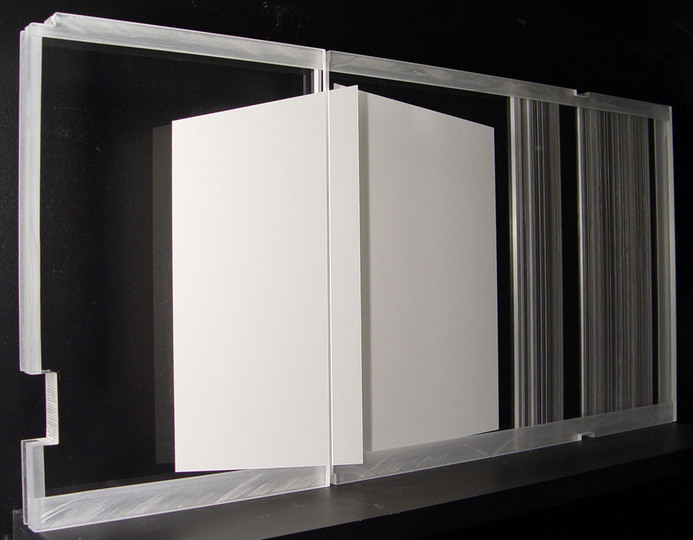
James Busby, One Hundred Forty Five, 2006. Courtesy of Stefan Stux Gallery.
Happenings: New York, 1958–1963
The Pace Gallery, 534 West 25th St.
Kim Dong Yoo
Hasted Kraeutler, 537 West 24th Street
Walter Martin & Paloma Muñoz: Night Falls
PPOW Gallery, 535 West 22nd Street, 3rd Floor
Janet Fish: Recent Paintings
DC Moore Gallery, 535 West 22nd Street, 2nd Floor
Lower East Side
The Exquisite Corpse Project
Essex Street Market Building, 80 Essex Street
G.T. Pellizzi & Ray Smith: The Execution Of Maximilian
Y Gallery, 165 Orchard Street
Garrett Pruter: Mixed Signals
Charles Bank Gallery, 196 Bowery

Garrett Pruter, Mixed Signals, 2011. Courtesy of Charles Bank Gallery.
The Hilton Brothers: Tyrants + Lederhosen
Christopher Henry Gallery, 127 Elizabeth Street
SoHo
Mark Price: Hyper 20XX
KESTING / RAY, 30 Grand Street
Downtown
Charles Lutz: Re-Make/Re-Model
Hionas Gallery, 89 Franklin Street
Brooklyn
Resident Talk: Bad at Sports and apexart Resident Nanna Nordström team up for a Full-of-Depth Interview
2 Kingsland Ave., Brooklyn, NY
Friday, February 10
Lower East Side
Juergen Teller
Lehmann Maupin, 201 Chrystie Street
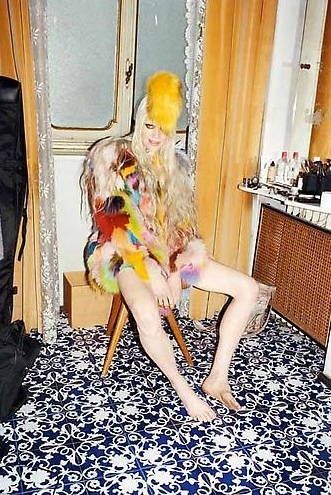
Juergen Teller, Kristen McMenamy Casa Mlino No. 2, 2011. Courtesy of Lehmann Maupin.
Caroll Taveras: Duality
F.L.O.A.T. Gallery, 195 Chrystie St.
Come and Get It!
Hendershot Gallery, 195 Chrystie Street
Chelsea
Amy Wilson
BravinLee programs, 526 West 26th Street, Suite 211
Cultural Production
Andrea Rosen Gallery, 525 W. 24th St
East Village
Dead Letter Office Hours
Independent Curators International, 799 Broadway, #205
Brooklyn
Sutured
Like the Spice, 224 Roebling Street

Adam Parker Smith, Proposal, 2012. Courtesy of Like the Spice Gallery
Per-Oskar Leu: Crisis and Critique
Triple Canopy, 155 Freeman St.
Saturday, February 11
Lower East Side
Adam Curtis: The Desperate Edge of Now
e-flux, 311 East Broadway
André Saraiva: Love Letters
Half Gallery, 208 Forsyth St
Brooklyn
Evan Robarts and James Moore
Open Source Gallery, 306 17th Street
Long Island City
Clifford Owens: Anthology, PERFORMANCE
MoMA PS1, 22-25 Jackson Ave

This week in New York, the Pace Gallery presents Happenings: New York 1958-1963, an exhibition chronicling five years of experimental performances that radically changed the course of contemporary art. Over three hundred photographs by five photographers feature major contributors to the movement such as Red Grooms, Allan Kaprow, and Claes Oldenburg. At e-flux’s headquarters, Hans Ulrich Obrist has curated an exhibition of Adam Curtis’ documentary films with exhibition design by Liam Gillick. Other highlights for the week include Ouattara Watts at Feedback Ltd., fine art and fashion photographer Juergen Teller at Lehmann Maupin, and a group show featuring Allen Ruppersberg and Alexandre Singh at Andrea Rosen Gallery.
For a full listing of this weeks events, click here
Wednesday, February 8
West Village
Ouattara Watts: Vertigo
Vladimir Restoin Roitfeld Feedback Ltd, 560 Washington Street
Lower East Side
Sarah Kurz: Made For Love
Allegra LaViola Gallery, 179 East Broadway
Material
Salon 94 Freemans, 1 Freeman Alley
Chelsea
TONY OURSLER: Screening + Conversation
Electronic Arts Intermix, 535 West 22nd Street, 5th Floor
Thursday, February 9
Chelsea
James Busby: Wingspan
Stefan Stux Gallery, 530 West 25th Street

James Busby, One Hundred Forty Five, 2006. Courtesy of Stefan Stux Gallery.
Happenings: New York, 1958–1963
The Pace Gallery, 534 West 25th St.
Kim Dong Yoo
Hasted Kraeutler, 537 West 24th Street
Walter Martin & Paloma Muñoz: Night Falls
PPOW Gallery, 535 West 22nd Street, 3rd Floor
Janet Fish: Recent Paintings
DC Moore Gallery, 535 West 22nd Street, 2nd Floor
Lower East Side
The Exquisite Corpse Project
Essex Street Market Building, 80 Essex Street
G.T. Pellizzi & Ray Smith: The Execution Of Maximilian
Y Gallery, 165 Orchard Street
Garrett Pruter: Mixed Signals
Charles Bank Gallery, 196 Bowery

Garrett Pruter, Mixed Signals, 2011. Courtesy of Charles Bank Gallery.
The Hilton Brothers: Tyrants + Lederhosen
Christopher Henry Gallery, 127 Elizabeth Street
SoHo
Mark Price: Hyper 20XX
KESTING / RAY, 30 Grand Street
Downtown
Charles Lutz: Re-Make/Re-Model
Hionas Gallery, 89 Franklin Street
Brooklyn
Resident Talk: Bad at Sports and apexart Resident Nanna Nordström team up for a Full-of-Depth Interview
2 Kingsland Ave., Brooklyn, NY
Friday, February 10
Lower East Side
Juergen Teller
Lehmann Maupin, 201 Chrystie Street

Juergen Teller, Kristen McMenamy Casa Mlino No. 2, 2011. Courtesy of Lehmann Maupin.
Caroll Taveras: Duality
F.L.O.A.T. Gallery, 195 Chrystie St.
Come and Get It!
Hendershot Gallery, 195 Chrystie Street
Chelsea
Amy Wilson
BravinLee programs, 526 West 26th Street, Suite 211
Cultural Production
Andrea Rosen Gallery, 525 W. 24th St
East Village
Dead Letter Office Hours
Independent Curators International, 799 Broadway, #205
Brooklyn
Sutured
Like the Spice, 224 Roebling Street

Adam Parker Smith, Proposal, 2012. Courtesy of Like the Spice Gallery
Per-Oskar Leu: Crisis and Critique
Triple Canopy, 155 Freeman St.
Saturday, February 11
Lower East Side
Adam Curtis: The Desperate Edge of Now
e-flux, 311 East Broadway
André Saraiva: Love Letters
Half Gallery, 208 Forsyth St
Brooklyn
Evan Robarts and James Moore
Open Source Gallery, 306 17th Street
Long Island City
Clifford Owens: Anthology, PERFORMANCE
MoMA PS1, 22-25 Jackson Ave
Subscribe to:
Posts (Atom)
